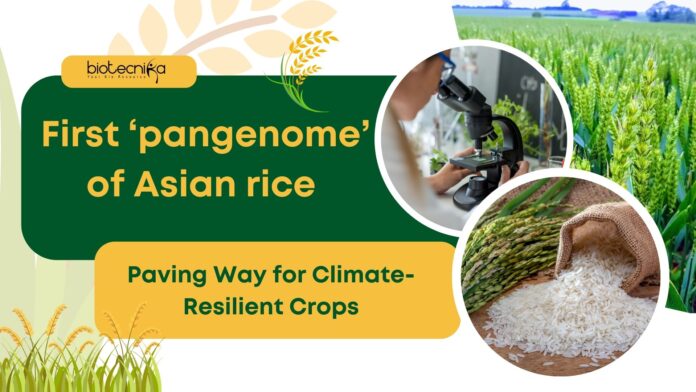The First ‘Pangenome’ of Asian Rice by Chinese Researchers; Paving Way for Climate-Resilient Crops
An international team led by the Chinese Academy of Sciences discovered the first-ever Asian rice pangenome. It was found by integrating genetic data from 144 diverse rice varieties, including wild and cultivated rice from Asia. The pangenome offers the most comprehensive reference of the rice genome to date.
It is much like the Human Genome Project, which mapped the genetic blueprint of humans two decades ago. The rice pangenome covers the entire range of genetic diversity across Asian rice.
The main advantage of this rice, its rich genetic resource, is expected to catalyze the other rice varieties. It is also expected to catalyze high yield capacity and its resistance to climate change, pests, and diseases.
What is a Pangenome?
- A pangenome is a comprehensive collection of all the genes found within a species, including core genes (shared by all individuals) and accessory or unique genes (present only in some individuals or populations). It offers a complete view of genetic diversity across a broad population of organisms.
What is rice Pangenome?
- The rice pangenome was discovered by analyzing the genomes of 144 wild and cultivated rice varieties across Asia. It is the first complete genomic resource for rice.
- Researchers led the project from the Chinese Academy of Sciences to explore rice evolution and domestication.
- Researchers used PacBio HiFi (High-Fidelity) sequencing and advanced computational tools to detect variations, uncovering 3.87 billion base pairs of genetic material previously missing from the standard rice genome.
- This approach discovers unknown genetic sequences, which enable a clear understanding of variation, evolution, and inheritance of traits.
In total, 69,531 genes were identified, including:
- 28,907 core genes (shared across all varieties)
- 13,728 genes specific to wild rice
- Additional genes unique to cultivated or region-specific varieties
- About 20% of all genes were related to the wild variety of rice. These genes are crucial for improving cultivated rice varieties.
Significant outcomes of discovery:
- All Asian cultivated rice varieties, such as Oryza sativa L, originate from Or-IIIa, a subgroup of Oryza rufipogon.
- A rice variety called Japonica is traditionally grown in China. It later spread across Asia through hybridization, leading to the emergence of indica rice in Asia.
- This study reveals that the specific genes in the wild variety were connected to environmental adaptation, phenotypic flexibility, and regenerative traits.
- This study helps to bridge the genetic gap between wild and cultivated rice, leading to adaptation to climate change and high yield capacity of the crop varieties.
Importance:
Why does this new discovery matter? This study is significantly contributing to evolution and adaptability. Rice is a staple food and has become a global staple, feeding approximately two-thirds of the world’s population.
In India, rice is the dominant crop grown in the monsoon season. It usually grows between June and September. Reports have shown a record output of 220 million tonnes over 51000 hectares with an average rice yield of about 4.2 tonnes per hectare in the agricultural year 2024–25.
Threats:
Several threats exist to this critical food source. Environmental changes, including climate change, are significantly impacting rice production.
- A temperature rise: The average temperature in India has already increased by 0.7°C since 1901. At present, 2024 was the hottest year so far, showing a record of minimum average temperature increase of 0.9°C.
- Erratic monsoon
- Environmental stress, like arsenic contamination, is especially prevalent in groundwater-irrigated regions. Increasing temperature may promote the uptake of arsenic in rice, leading to an increase in arsenic contamination, which damages the health and stability of the crop.
Evolutionary Insights
This study provides strong evidence for the evolutionary relationship between the wild rice type and the cultivated one. It supports the evolutionary theory stating that all Asian cultivated rice (Oryza sativa) can be traced back to the wild ancestor variety (Or-IIIa). Or-llla is a subgroup of Oryza rufipogon and is believed to be the primary progenitor of the japonica rice species in China. Later, as japonica varieties migrated southward and westward, they interbred with another wild subgroup, Or-I, giving rise to indica rice, the most widely grown variety in India.
A Gateway to Climate-Smart Agriculture
This pangenome project offers a treasure trove of genes that govern traits like drought tolerance, heat resistance, yield optimization, grain quality, and nutrient use efficiency. By analyzing the 20% of genes unique to wild rice, scientists now have the tools to reintroduce lost traits, some of which may be critical for helping rice adapt to rapid environmental changes.
The Indian Council of Agricultural Research (ICAR) announced the development of two promising genetically modified rice lines this month. These two genetically modified rice varieties, Samba Mahsuri and MTU 1010, are designed for higher yields and better drought resilience. While these are yet to be deployed in farmers’ fields, access to a richer genomic library, like the new pangenome, could fast-track such innovations.
Global and Local Implications
Beyond academic achievement, the rice pangenome sets the stage for:
- Precision breeding using genome-editing tools like CRISPR
- Development of region-specific rice varieties suited to local agroclimatic conditions
- Conservation and utilization of wild rice genetic resources, which are often overlooked in traditional breeding
- Enhancing food and nutritional security, especially in vulnerable regions.
This milestone in rice genomics is about unlocking nature’s code and future-proofing one of humanity’s most vital crops.
“By bridging the gap between wild and cultivated rice genetics, our study opens new avenues for developing superior and more productive rice varieties,” the authors noted in their publication. “These improved varieties could incorporate valuable traits from wild rice species, potentially enhancing their resilience to rapid environmental changes.”
As the world races to adapt agriculture to a changing planet, the rice pangenome may be one of the most vital tools in scientists’ arsenals.























